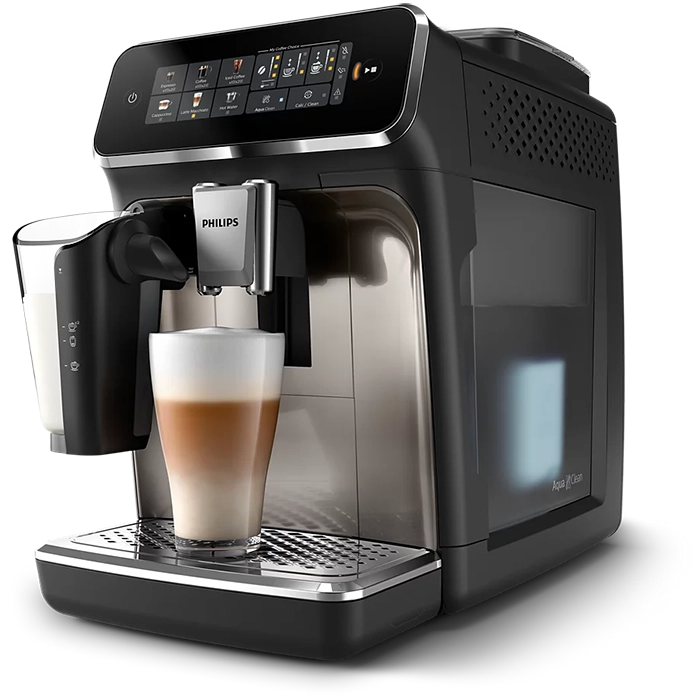Quick Specs
Our Verdict
ProsStraightforward to use.Simple to maintain.Efficient Latte Go system.Accessible extraction unit.Low noise level.ConsOvercrowded control panel.Slightly long start-up time. n <a href="https://amz
Pros
- Straightforward to use.
- Simple to maintain.
- Efficient Latte Go system.
- Accessible extraction unit.
- Low noise level.
Cons
- Overcrowded control panel.
- Slightly long start-up time.
As an Amazon Associate, I earn commission from qualifying purchases.
The Philips Series 3300 espresso machine impresses not only with its multitude of options (ceramic grinder, five direct-access recipes, LatteGo system, SilentBrew function) but also with its attractive pricing.
<strong>Overview</strong>
In Philips' bean-to-cup coffee machine range, the Series 3300 represents the mid-tier. More advanced than the Series 2200 with its LatteGo system for milk-based drinks, yet offering fewer recipes than the Series 5500, the Series 3300 aims to merge the best of both segments. It enables the preparation of five coffee and milk-based drink recipes. Launched at €429, this espresso machine fine-tunes the shortcomings of previous models, starting with the SilentBrew system designed to reduce the noise of the grain grinder, thereby avoiding waking the entire household in the morning. Besides, this bean-to-cup machine follows tradition with a 15-bar pressure pump, five recipes accessible from the control panel, the LatteGo system for milk-based beverages, a 1.8-litre water tank, and a 275g bean hopper.

<strong>Ease of Use</strong>
The Philips Series 3300 doesn't deviate from established aesthetic norms, mirroring previous generations. We're faced with a machine slightly bulkier than a Smeg or Kottea, featuring square lines and a robust plastic casing that seems capable of withstanding the test of time—a classic!
The control panel also remains the same and continues to avoid minimalism. Instead of a touchscreen, it boasts a series of easily identifiable icons that leave little doubt about their functions. The recipes are spelled out, simplifying coffee preparation. Thus, traditional espresso, long coffee, cappuccino, latte macchiato, and a hot water dispensing function are all available.
Preparing a drink is straightforward: select the beverage, adjust settings like aroma strength (three levels), cup size, or milk quantity for milk-based drinks, and press the Play button to start brewing. The lack of a touchscreen can make certain adjustments, such as temperature setting (three levels), which is not directly accessible, a bit complicated. This setting is far from intuitive, requiring the machine to be turned off and then restarted by long-pressing the coffee length selection button. Similarly, the duration before entering standby mode is adjusted in the same maer.
Nestled at the top of the machine, the bean hopper has a capacity of 275g. Coffee enthusiasts have another way to tailor the taste of their preferred drink: adjusting the grind fineness across 12 levels. Remember, the coarser the grind, the weaker the coffee; the finer the grind, the more intense the aroma, as the water remains in contact with the grounds for longer. However, adjusting the knob can be tricky, requiring a firm press and twist simultaneously, and some beans can mischievously get stuck under the dial.
The grinder is ceramic, a rarity for a coffee machine in this price bracket. Unlike steel, ceramic does not heat up, which should not alter the taste of the coffee. However, it is known to be more fragile. This bean hopper, complemented by a chute for ground coffee, is quite convenient for those who occasionally desire a decaf. It closes with a rubber-sealed lid to ensure airtightness, thus preserving the aroma of the beans—a welcome feature. It also contributes to the machine's sound insulation, particularly noticeable during the grinding of coffee beans.
The water tank, which can accommodate a filter cartridge (supplied by the manufacturer), is positioned on the right side of the machine and is much easier to remove than those on some models placed at the rear. Replacing it is just as straightforward, unlike rear containers that sometimes require multiple attempts. With a volume of 1.8 litres, it's large enough to avoid frequent refilling after five or six espressos. Philips' renowned LatteGo system is also included. Its use is simple: pour the desired amount of milk for your recipe (the carafe is graduated) and select the beverage. The machine then heats, froths the milk, and dispenses it directly into the cup. Even installing it on the steam circuit for frothing milk is effortless. It's consistently a success!

<strong>Ease of Maintenance</strong>
Like many automatic machines, the Series 3300 rinses its nozzles upon startup and shutdown—a good practice for hygiene. Maintenance notifications, such as when to refill the bean hopper or water tank, are indicated via LEDs similar to those used for coffee making. Conveniently, the button to initiate the descaling process is directly accessible.
The extraction group can be easily removed for thorough cleaning. It's accessible by removing the water tank and opening the hatch.
Turning back to the LatteGo system, its ease of cleaning is notable. The carafe consists of two parts. The first, transparent, holds the milk, while the second, when clipped on, covers a groove in the first part. Removing the black piece reveals the milk circuit for thorough cleaning. Those particularly keen on hygiene will appreciate the simplicity and effectiveness of this maintenance.
<strong>Speed</strong>
The Series 3300 is not among the fastest models in our comparison. The first morning coffee is ready in 1 minute and 40 seconds, including startup, preheating, nozzle rinsing, grain grinding, and extraction. The second coffee follows 10 seconds later, after the machine resets, and is delivered after a total of 2 minutes and 20 seconds.
Energy Consumptio The time before entering standby mode on the Series 3300 can be easily set to 15, 30, 60, or 180 minutes—we recommend choosing the shortest duration. When idle, it consumes a modest 1.1 W. When turned off, it uses 0.2 W; while this is low, we advise completely unplugging the machine. During coffee preparation, the energy consumption is reasonable. With three espressos and three long coffees per day, it uses 0.072 kWh, equating to a cost of 15 cents per month on the electricity bill.
<strong>Noise</strong>
Where the Series 3300 iovates is with its Silent Brew function, significantly reducing the noise of the grinder. Placed 1 metre away from the user, the machine emits just 56 dB (A) during bean grinding—an excellent performance, as most models in our comparison often exceed 60 dB (A). The extractiooise level is normal, around 47 dB (A).
<strong>Conclusion</strong>
The Philips Series 3300 is an espresso machine that could please everyone. While it sticks to the basics in terms of coffee recipes, it excels in delivering essential beverages, with milk-based drinks enhanced by the efficient LatteGo system. Although not the fastest, its quiet operation is a notable feature in this product category.
n Order Now At AmazoAs an Amazon Associate, I earn commission from qualifying purchases.
Ready to Purchase?
Check current prices and availability on Amazon
Affiliate Disclosure: Truthful Reviews is a participant in the Amazon Services LLC Associates Program and Amazon EU Associates Programme, affiliate advertising programs designed to provide a means for sites to earn advertising fees by advertising and linking to Amazon.com and Amazon.co.uk. This means if you click on an Amazon link and make a purchase, we may receive a small commission at no extra cost to you. This helps support our independent testing and honest reviews. Our editorial content is never influenced by advertisers or affiliate partnerships.

